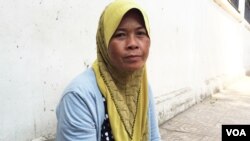Each morning, Phan Kha drags her cart full of mussels through the streets of Phnom Penh. She pulls the cart up to 20 kilometers a day, and on a good day, she makes $10.
The cart provides a living, allowing her to pay her $20 in rent each month and to have enough to eat. But on a recent morning, Phan Kha, 59, said she has few options. She did not have a high school education, and she has a family of eight grandchildren to help care for.
“Sometimes I could make 50,000 riel, or sometimes 60,000 riel,” she said. “It depends. Sometimes the cart stays full, as it is now.”
There are many Cambodian women like her, forced into menial labor by a lack of opportunity and education. And as US Secretary of State John Kerry prepares for a visit next week, Phan Kha’s story and others highlight the huge challenges faced by policymakers in creating more gender equality for women and more opportunities for Cambodia’s poor, in general.
The World Bank says that though Cambodia has greatly reduced its poverty rate, “a vast majority of families who escaped poverty were only able to do so by a small margin.” That has left a huge number of “near-poor,” about 90 percent of Cambodians living in rural areas. Of Cambodia’s 15 million people, 3 million are poor and 8.1 million are near-poor.
Not far from Phan Kha and her cart, Talaois Sarifas, 44, was accompanying a relative to a hospital. She is a fisherman from Kampong Cham province, making about 15,000 riel, or less than $4, on a good day, she said. “These days, fish are very scarce. I can only catch one or two fish sometimes per day.”
Some days, she thinks about finding work in Malaysia, but both her mother and her children are in her care. “The difficulty is that I’m poor, and my children are studying,” she said. “I would like to have a small shop to sell clothes from, but I don’t have any money.”
Nearby, Touch Dany, a 32-year-old soft drink vendor, has her own mobile cart. She works from early in the morning until after dark and returns home to chores and children. “After the business, when I get back home, I have to do the kitchen things and tidy the house,” she said. Sometimes she doesn’t go to bed until midnight.
All three women were found around one street in Phnom Penh. And it could have been any street. In the countryside, things are even more economically dire. Finding ways to improve the lives of Cambodian women is a major undertaking.
USAID’s senior coordinator for gender equality and women’s empowerment, Susan Markham, told VOA Khmer on a visit to Cambodia last year that improving the lives of women here require robust institutions to tackle poverty. And that’s not only in the government, but in the private sector.
“It’s really a whole wrap of factors that come together,” she said. “You need good governance, from the parliamentary level all the way down to the local level. You need to have people being educated and feeling that education is actually important for jobs. So it is a wide range of factors that need to be addressed.”








